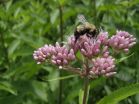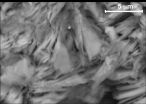(Press-News.org) Global warming is putting the squeeze on bumblebees. In the most comprehensive study ever conducted of the impacts of climate change on critical pollinators, scientists have discovered that global warming is rapidly shrinking the area where these bees are found in both North America and Europe.
Researchers examined more than 420,000 historical and current records of many species of bumblebees--and confirm that bumblebees are in steep decline at a continental scale because of climate change. The new research is reported in the journal Science.
ECONOMIC THREATS
This shrinking range is bad news for more than bees. "Bumblebees pollinate many plants that provide food for humans and wildlife," says Leif Richardson, a scientist at the University of Vermont who helped lead the new research. "If we don't stop the decline in the abundance of bumblebees, we may well face higher food prices, diminished varieties, and other troubles."
"Pollinators are vital for food security and our economy, and widespread losses of pollinators due to climate change will diminish both," stated Jeremy Kerr, a biologist from the University of Ottawa, who led the new study. "We need to figure out how we can improve the outlook for pollinators at continental scales, but the most important thing we can do is begin to take serious action to reduce the rate of climate change."
With climate change, many species of animals, including butterflies, have been observed to expand their territory: the northern edge of their range marches toward the North Pole--while the southern edge remains in place. Not so bumblebees. The team of fourteen scientists who conducted the new study found that northern populations of many bumblebee species are staying put--while the southern range edge is retreating away from the equator.
"This was a surprise," said Richardson, a bee expert at UVM's Gund Institute for Ecological Economics. "The bees are losing range on their southern margin and failing to pick up territory at the northern margin--so their habitat range is shrinking."
CLEARLY, IT'S CLIMATE
The new study shows that the culprit is not pesticides and it's not land use changes--two other major threats to bumblebee populations and health. Instead, the research shows clearly that this "range compression," as the scientists call it, tracks with warming temperatures.
The team also found that bumblebees are shifting to areas of habitat at higher elevation in response to climate change. "Moving upslope doesn't necessarily mean they've lost area there yet," said UVM's Richardson, "but, eventually, they may simply run out of hill."
To conduct their study, the scientist drew on geo-referenced databases from museum collections on both continents. In Vermont, Leif Richardson examined bee specimens at UVM's Zadock Thompson Zoological Collections.
EVOLUTIONARY EXPLANATIONS
Over the 110 years of records that the team examined, bumblebees have lost about 185 miles (300 km) from the southern edge of their range in Europe and North America, the scientists estimate. "The scale and pace of these losses are unprecedented," said Ottawa's Jeremy Kerr.
There may be an evolutionary explanation for the problems bumblebees now face. Many other species of insects originated and diversified in tropical climates; as temperatures warm, their evolutionary history may allow them to better adapt. Bumblebees, however have "unusual evolutionary origins in the cool Palearctic," the scientists write, which may help explain their rapid losses of terrain from the south and lagging expansion in the warming north.
ASSISTED MIGRATION?
To respond to this problem, the research team suggests that a dramatic solution be considered: moving bee populations into new areas where they might persist. This "assisted migration" idea has been considered--and controversial--in conservation biology circles for more than a decade, but is gaining support as warming continues.
"We need new strategies to help these species cope with the effects of human-caused climate change, perhaps assisting them to shift into northern areas," said Kerr. But the most important message of this study is "the need to halt or reverse climate warming," says Leif Richardson, a USDA National Institute of Food and Agriculture postdoctoral research fellow at UVM.
"These findings could spell trouble for many plants--including some crops, like blueberries--that depend on bumblebees for pollination," he said. "Bumblebees are crucial to our natural ecosystems."
INFORMATION:
The discovery of a fiber-reinforced, concrete-like rock formed in the depths of a dormant supervolcano could help explain the unusual ground swelling that led to the evacuation of an Italian port city and inspire durable building materials in the future, Stanford scientists say.
The "natural concrete" at the Campi Flegrei volcano is similar to Roman concrete, a legendary compound invented by the Romans and used to construct the Pantheon, the Coliseum, and ancient shipping ports throughout the Mediterranean.
"This implies the existence of a natural process in the subsurface ...
Researchers from the University of Calgary and University of Ottawa have made an astonishing find when it comes to the habitat range of bumble bees, and the results are troubling.
Findings to be published in the Journal Science, demonstrate that climate change is having a significant impact on bumblebee species in North America and Europe.
Bumblebees are losing vital habitat in the southern regions of North America and Europe, which is cause for concern but another pressing issue is that bumblebee species generally haven't expanded north," explains Paul Galpern, Assistant ...
TORONTO, July 9, 2015 - Bumblebees are rapidly declining in both North America and Europe, and a new study points to climate change as the major factor. The study, a comprehensive analysis of how climate change impacts these critical pollinators, was published in Science today.
The research shows that bumblebees are losing large amounts of the southern portion of their ranges, but unlike other species which are compensating by moving further north as the climate warms, bumblebees are not heading north. Their range areas are compressing with rapid warming and this is causing ...
This news release is available in Japanese.
A suite of energy-saving traits, including underactive thyroid glands, allows giant panda bears to survive almost exclusively on bamboo, according to a new study. Yonggang Nie and colleagues report the first measurements of daily energy expenditure (DEE) in these bears, which do not have stomachs designed for such low-nutrient, high-cellulose plants. The researchers studied five captive pandas and three wild ones, discovering that the animal's DEE was just about 38% of the average for a terrestrial mammal with ...
This news release is available in Japanese. How does the Campi Flegrei caldera, or subsurface rock, near Naples, Italy, withstand more uplift than other calderas without erupting? A new study shows that the caprock underlying this particular caldera closely resembles ancient Roman concrete -- and that the rock's microstructures, characterized by intertwining fibrous minerals, lead to its exceptionally high strength. The findings help to explain how the caldera has been able to withstand tremendous deformation, such as the large uplift episode that began in 1982 and raised ...
This news release is available in Japanese.
While the geographic ranges of many animals are expanding northward in response to climate change, those of North American and European bumblebee species are shrinking, a new study shows. These insects are failing to migrate northward, the study reveals, and in their southern territories, their ranges are compressing -- with range losses up to 300 kilometers in both North America and Europe. The findings reveal the vulnerability of these pollinators, which play key roles in agriculture, to a warming world, hinting that they ...
This news release is available in Japanese.
Researchers have designed a more efficient jumping robot with three-dimensional (3D) printing techniques and a combination of hard and soft materials. Inspired by designs in nature, such as snakes or insect larvae, soft-bodied robots are safer, more adaptable, and more resilient than their traditionally rigid counterparts, but molding and powering them has proved challenging. Now, Nicholas Bartlett and colleagues report a technique for designing and manufacturing untethered, frog-like jumping machines with ...
Traditional industrial robots are rigid -- mostly metal -- and are fast, precise and powerful. Their speed and precision comes at the cost of complexity and can often pose a danger to humans who get too close. Soft robots are adaptable and resilient but slow, difficult to fabricate, and challenging to make autonomous because most motors, pumps, batteries, sensors, and microcontrollers are rigid.
But what if you could combine the autonomy and speed of a rigid robot with the adaptability and resiliency of a soft robot -- and do it relatively cheap and fast?
Harvard engineers ...
Monterey, CA - Thousands of feet below the ocean's surface lies a hidden world of undiscovered species and unique seabed habitats--as well as a vast untapped store of natural resources including valuable metals and rare-earth minerals. Technology and infrastructure development worldwide is dramatically increasing demand for these resources, which are key components in everything from cars and modern buildings to computers and smartphones. This demand has catalyzed interest in mining huge areas of the deep-sea floor.
In a paper published this week in Science, researchers ...
Engineers at Harvard University and the University of California, San Diego, have created the first robot with a 3D-printed body that transitions from a rigid core to a soft exterior. The robot is capable of more than 30 untethered jumps and is powered by a mix of butane and oxygen. Researchers describe the robot's design, manufacturing and testing in the July 10 issue of Science magazine.
"We believe that bringing together soft and rigid materials will help create a new generation of fast, agile robots that are more robust and adaptable than their predecessors and can ...







